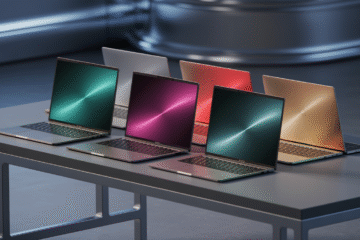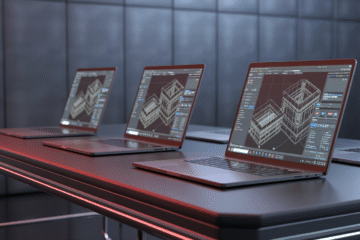Best Budget Laptops Under $500 (2025 Buyer’s Guide + Top 5 Picks)
If you’re shopping under $500, you’re walking a tightrope: you want a laptop that feels quick, lasts all day, and won’t give up six months later. The good news? 2025’s budget tier is better than ever—solid-state storage is standard, 8GB RAM is common, and even entry chips handle everyday work, streaming, and light content creation. The key is choosing smartly: don’t chase big numbers where they don’t matter, and do invest where performance and comfort actually show up.
Below is a clean, practical guide to buying the right sub-$500 machine—followed by a ranked countdown of five models worth shortlisting right now.
How to Choose a Sub-$500 Laptop in 2025
Prioritize Real-World Speed (Not Just Benchmarks)
At this price, a modern entry-level CPU (Intel/AMD) plus an SSD will feel far faster than older chips paired with slow hard drives. For web, docs, email, Zoom, and streaming, CPU differences matter less than you think—what you’ll actually feel is memory and storage.
RAM and Storage: Where Budget Performance Lives
-
8GB RAM is today’s realistic baseline. With 4GB, you’ll hit tabs and app limits quickly. If you can find a configuration with 16GB near $500, it’s a strong longevity play.
-
256GB SSD is the sweet spot. 128GB fills fast after updates and offline media. A snappy NVMe SSD will keep launch times short and updates painless.
Display & Comfort: The Hidden Productivity Multiplier
-
1080p (FHD) is the minimum target. Lower resolutions look soft and give you less usable space.
-
Brightness and panel type matter. IPS panels look better off-axis and for movies. In budget land, you’ll often accept 250–300 nits; just know outdoor use will be limited.
-
Keyboard/Trackpad: Look for a well-spaced layout and a precise, stable trackpad. These two affect daily satisfaction more than a tiny CPU bump.
Battery Life & Portability
Under $500, expect 6–10 hours depending on your workload. If you want a “charge once and forget” experience, favor efficient chips and 14–15-inch designs with modest brightness. Heavier gaming-style chassis will drain faster.
Upgrade Paths & Serviceability
Some budget models let you add RAM or swap the SSD; others are sealed. If you plan to keep the laptop for 3–4 years, upgradability is a cheap way to extend life later.
Windows “S Mode” and Bloat
Many entry machines ship with Windows in S Mode for security. You can switch out for free to install desktop apps—but do it only if you need to. Also, uninstall trialware/bloat on day one for cleaner performance.
The Top 5 Best Budget Laptops Under $500 (2025)
Ranked from versatile value picks to the best all-rounder in this price band. Exact specs vary by retailer/region; use the “What to look for” notes to pick the right configuration under $500.
5- Acer Aspire 3 Laptop
Why it stands out:
The Aspire 3 is a classic “do-the-basics” 15-inch notebook that consistently punches above its price. Acer’s formula is simple: a modern entry CPU, SSD storage, and a full-size keyboard in a clean chassis. It’s the sort of computer that boots fast, opens a dozen browser tabs without drama, and just lets you work.
Best for:
Students, home offices, and everyday users who want a big screen for spreadsheets, docs, and casual streaming.
What we like
-
Reliable performance for web, Office/Docs, Zoom, and email
-
Full-size keyboard (often with numpad) for data entry and budgeting
-
Competitive pricing with frequent promotions
Keep in mind
-
Base displays can be average—check for IPS/FHD panels
-
Speakers/mics are fine for calls, but not “media-centric”
-
Heavier than ultrabooks; not ideal for constant travel
What to look for under $500
-
8GB RAM, 256GB SSD, and an IPS 1080p panel
-
Current-gen entry CPU (Intel/AMD) for efficient battery use
Bottom line:
A trustworthy large-screen laptop that gets the work done without fuss. If you’re balancing spreadsheets, online classes, and casual entertainment, Aspire 3 delivers predictable value.
4- ASUS Vivobook Go Slim Laptop
Why it stands out:
The Vivobook Go Slim aims for portability and style without losing the essentials. You get a lighter chassis than typical budget 15-inchers and a surprisingly comfortable typing experience. For commuters and students who carry their laptop daily, the “Go Slim” ethos makes a real difference.
Best for:
On-the-go learners and professionals who want a lighter bag and a cleaner design.
What we like
-
Slim, modern design that’s easy to carry
-
Snappy day-to-day feel thanks to SSD and optimized thermals
-
Often better keyboard/trackpad tuning than competitors in this range
Keep in mind
-
Slim builds may reduce port variety—check for the I/O you need
-
Some trims use TN/non-IPS panels; verify the display spec
-
Storage may start at 128GB—prefer 256GB if possible
What to look for under $500
-
8GB RAM, 256GB SSD, 1080p IPS panel
-
Two USB-A ports + USB-C and HDMI for basic peripherals
Bottom line:
If you’re moving all day between classes, cafes, and buses, the Vivobook Go Slim provides a friendlier carry while staying responsive for everyday workloads.
3- NIMO N151 IPS FHD Laptop
Why it stands out:
The NIMO N151 is a lesser-known budget hero that frequently surfaces with an IPS Full HD display at a price where competitors still ship dimmer panels. That single detail makes a big difference for reading, streaming, and long study sessions. Pair it with an SSD and 8GB RAM, and you get a machine that feels crisp for the money.
Best for:
Value hunters who prioritize a better screen for Netflix, research, and multi-tab study marathons.
What we like
-
IPS Full HD panel improves clarity and viewing angles
-
Clean, simple configuration often focused on essentials
-
Competitive pricing that undercuts big brands
Keep in mind
-
Smaller-brand quality control and after-sales support can vary
-
Speakers and webcam are usually functional, not premium
-
Check keyboard layout photos if you type long hours
What to look for under $500
-
IPS 1080p panel (non-negotiable—that’s the N151 advantage)
-
8GB RAM and at least 256GB SSD for a smooth baseline
Bottom line:
If you care about screen quality on a strict budget, the N151’s IPS FHD display makes text sharper and binge-watching nicer than most rivals near this price.
2- HP Stream HD BrightView Laptop
Why it stands out:
The HP Stream line focuses on a lightweight, cloud-first experience. Think Docs, Sheets, web apps, and streaming—not heavy desktop workloads. What you get in return is a compact machine with simple setup, quiet operation, and excellent battery sipping if your life lives in the browser.
Best for:
Web-first users, writers, and students primarily using cloud apps and streaming—people who want a light, simple machine that stays out of the way.
What we like
-
Often very lightweight and fan-quiet
-
Simple Windows S Mode experience for safe, basic use
-
Strong battery efficiency for long library days
Keep in mind
-
Storage can be tight—128GB or even 64GB on older trims
-
BrightView displays are glossy; reflections in bright rooms
-
Not for heavy multitasking or desktop-grade creative apps
What to look for under $500
-
8GB RAM if available, or be disciplined with tab counts
-
128–256GB storage (or plan cloud + microSD/USB expansion)
-
Brightness around 250 nits minimum; higher if you sit near windows
Bottom line:
For email, research, and streaming with maximum simplicity and portability, the Stream is a breezy choice—as long as you keep expectations web-centric.
1- Lenovo IdeaPad 115IJL7 Laptop
Why it stands out:
Lenovo’s IdeaPad series has quietly become the budget all-rounder benchmark. The 115IJL7 flavor focuses on a balanced spec sheet and a sturdy build that feels better than the price suggests. It’s the kind of laptop that boots quickly, handles a pile of browser tabs, and still has enough polish to make daily work feel comfortable.
Best for:
Anyone who wants a dependable daily machine under $500 that doesn’t feel “cheap,” with sensible design choices and a trackpad/keyboard that get the fundamentals right.
What we like
-
Balanced components for smooth everyday performance
-
Lenovo keyboard feel—comfortable for long typing sessions
-
Often easier serviceability for SSD (and sometimes RAM) upgrades
Keep in mind
-
Base screens can be average; prioritize 1080p IPS where possible
-
Speaker quality is serviceable, not cinematic
-
Expect plastic builds; durability is good, but not premium-metal tier
What to look for under $500
-
8GB RAM (16GB if you find a promo), 256GB SSD
-
1080p IPS panel for better clarity and viewing angles
-
USB-C plus at least one USB-A, and HDMI for external displays
Bottom line:
It’s the safest “buy it and get on with your life” option in this tier. The IdeaPad 115IJL7 earns the top spot by combining everyday speed, typing comfort, and practical upgradability.
Feature Priorities: What Matters Most at $500 (and What Doesn’t)
Must-Haves
-
SSD (NVMe if possible): Non-negotiable for fast boot/app loads.
-
8GB RAM minimum: Keeps the machine responsive with multiple tabs/apps.
-
1080p display: Makes reading, writing, and streaming significantly better.
Nice-to-Haves
-
IPS panel: Better color and angles than TN.
-
Upgradeable storage: A $30–$50 SSD later can double capacity, stress-free.
-
USB-C charging: One charger for phone, tablet, and laptop simplifies life.
Don’t Overpay For
-
RGB keyboards or “gaming styling” at this price—they usually come with compromises elsewhere.
-
Huge storage out of the box. A 256GB SSD plus cloud or external drive is often a smarter budget split.
-
Ultra-thin chassis if it means dim screens and poor thermals.
Who Should Buy Which?
-
Writers, researchers, and spreadsheet warriors:
Lenovo IdeaPad 115IJL7 or Acer Aspire 3 for comfortable keyboards and steady performance. -
Students constantly on the move:
ASUS Vivobook Go Slim for lighter carry; if your needs are 100% web-centric, the HP Stream is featherweight and simple. -
Screen Quality on a Shoestring:
NIMO N151 IPS FHD—the IPS panel is the difference you’ll feel daily.
Set-Up Tips to Make a $500 Laptop Feel Like $800
-
Clean the bloat: Uninstall trials and manufacturer add-ons you don’t use.
-
Browser discipline: Set up a tab manager and content blockers; RAM stays happy.
-
OneDrive/Drive/iCloud: Keep local storage lean and your files synced.
-
External monitor: A 24–27″ 1080p/1440p monitor turns any budget laptop into a productivity station.
-
Cooling stand: A $20 stand improves thermals and typing angle during long sessions.
-
RAM/SSD upgrades (if supported): The best bang-for-buck “new laptop” feeling, 12–18 months down the line.
FAQs: Budget Laptops in 2025
Q: Can a sub-$500 laptop handle photo/video editing?
A: Light edits and short clips—yes. Full projects with many layers—probably not. Prioritize models with 8GB RAM and an SSD; use proxy workflows in entry-level editors.
Q: Is ChromeOS a better value under $500?
A: If you live in the browser and rely on web apps, yes—Chromebooks can feel faster given similar hardware. But if you need Windows apps, stay with Windows.
Q: How long will a $500 laptop last?
A: With care and modest workloads, 3–4 years is realistic. Choose SSDs and 8GB+ RAM for longevity.
Q: Should I switch out of Windows S Mode?
A: Only if you need apps not in the Microsoft Store. S Mode is safer and lighter for basic use.
The Bottom Line
Under $500, the smartest buy is the one that gets the fundamentals right: SSD speed, 8GB RAM, and a 1080p (ideally IPS) display. From our ranked picks:
-
Lenovo IdeaPad 115IJL7 earns the top spot as the safest, most balanced daily driver.
-
HP Stream HD BrightView is the web-first minimalist’s best friend.
-
NIMO N151 IPS FHD stands out with a nicer screen in the bargain bin.
-
ASUS Vivobook Go Slim brings portability and cleaner design to a tight budget.
-
Acer Aspire 3 remains the dependable big-screen workhorse that just works.
Choose the configuration that hits these targets, add a good cloud setup and an external monitor, and you’ll have a budget rig that feels far more expensive than the receipt suggests.



0 Comments